Volkswagen Group: History, Marketing Strategy, and Competition Analysis
Added on 2023-06-12
21 Pages4765 Words227 Views
Volkswagen Group 1
VOLKSWAGEN GROUP
Name:
Institution:
Course:
Tutor:
Date:
VOLKSWAGEN GROUP
Name:
Institution:
Course:
Tutor:
Date:
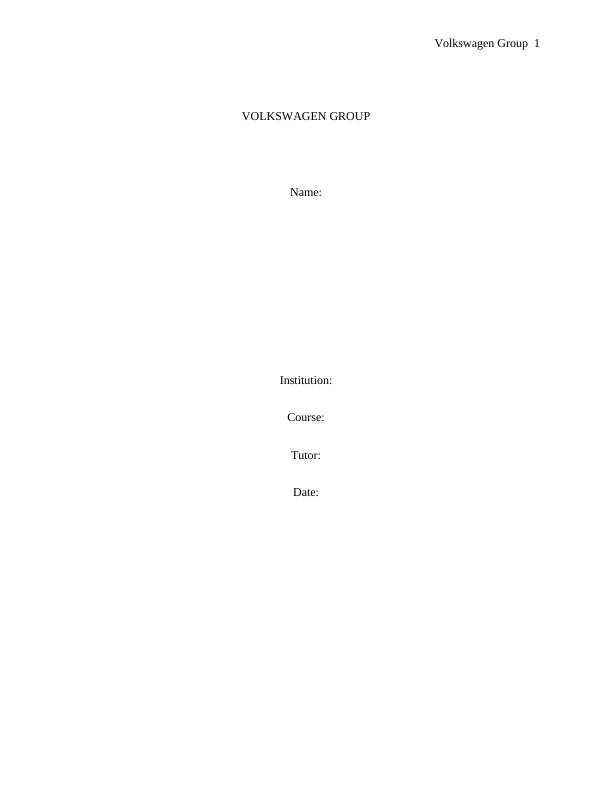
Volkswagen Group 2
Table of Contents
1.0.0 Introduction.................................................................................................................................3
1.1.0 Volkswagen Group History.....................................................................................................3
2.0.0 Marketing Segmentation and Strategy................................................................................................4
3.0.0 Competition Analysis.........................................................................................................................8
3.1.0 Major Competitors..........................................................................................................................8
4.0.0 SWOT analysis of Volkswagen Group.........................................................................................10
4.1.0 Strengths...................................................................................................................................10
4.1.1 Strong Brand Expansion through Diversification.....................................................................10
4.1.2 Innovativeness..........................................................................................................................11
4.1.3 Strong manufacturing base across the world.............................................................................11
4.2.0 Weaknesses...................................................................................................................................12
4.2.1 Stiff Competition......................................................................................................................12
4.3.0 Opportunities................................................................................................................................12
4.3.1 Opportunity for a Hybrid Car....................................................................................................12
4.4.0 Threats..........................................................................................................................................12
4.4.1 Increasing Stiff Competition.........................................................................................................12
5.0.0 Management Strategy.......................................................................................................................13
5.1.0 Differentiation..............................................................................................................................13
5.2.0 Cost Leadership............................................................................................................................14
5.3.0 Focus Strategy..............................................................................................................................14
6.0.0 Corporate Responsibility..................................................................................................................14
7.0.0 Conclusion........................................................................................................................................15
8.0.0 List of References.............................................................................................................................17
9.0.0 Appendices.......................................................................................................................................21
Table of Contents
1.0.0 Introduction.................................................................................................................................3
1.1.0 Volkswagen Group History.....................................................................................................3
2.0.0 Marketing Segmentation and Strategy................................................................................................4
3.0.0 Competition Analysis.........................................................................................................................8
3.1.0 Major Competitors..........................................................................................................................8
4.0.0 SWOT analysis of Volkswagen Group.........................................................................................10
4.1.0 Strengths...................................................................................................................................10
4.1.1 Strong Brand Expansion through Diversification.....................................................................10
4.1.2 Innovativeness..........................................................................................................................11
4.1.3 Strong manufacturing base across the world.............................................................................11
4.2.0 Weaknesses...................................................................................................................................12
4.2.1 Stiff Competition......................................................................................................................12
4.3.0 Opportunities................................................................................................................................12
4.3.1 Opportunity for a Hybrid Car....................................................................................................12
4.4.0 Threats..........................................................................................................................................12
4.4.1 Increasing Stiff Competition.........................................................................................................12
5.0.0 Management Strategy.......................................................................................................................13
5.1.0 Differentiation..............................................................................................................................13
5.2.0 Cost Leadership............................................................................................................................14
5.3.0 Focus Strategy..............................................................................................................................14
6.0.0 Corporate Responsibility..................................................................................................................14
7.0.0 Conclusion........................................................................................................................................15
8.0.0 List of References.............................................................................................................................17
9.0.0 Appendices.......................................................................................................................................21
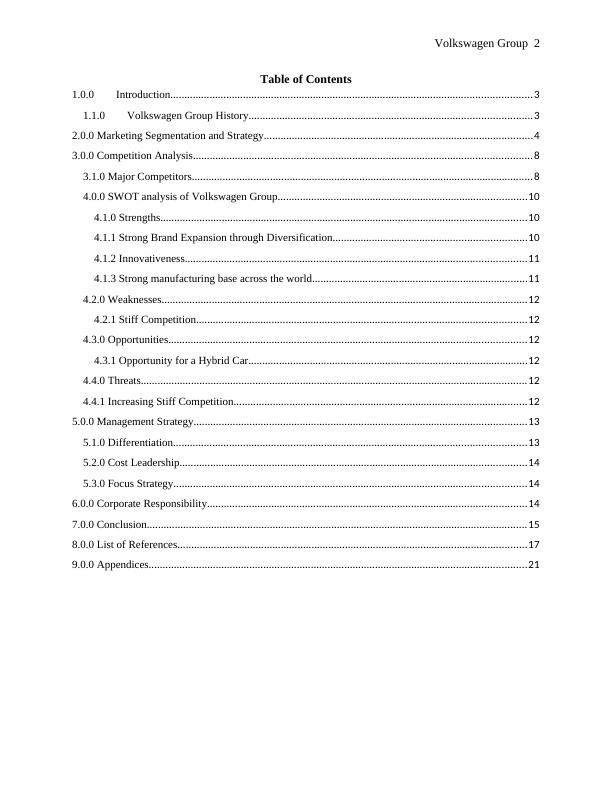
Volkswagen Group 3
1.0.0 Introduction
Volkswagen Group is a German based automobile companies that were initially formed
under the rule of then Adolf Hitler in 1937 after approval of Ferdinand Porsche’s design that was
commonly known as the “people’s car”(Mernitz 2015,p.190). The Volkswagen Group main goal
is to offer eye-catching, safe, and environmentally reliable motors that meet the customer's
various needs and that can command the stiff market share.
1.1.0 Volkswagen Group History
The company initially referred as Gesellschaft zur Vorbereitung des Deutschen
Volkswagens mbH , later renamed as Volkswagenwerk under the controlled by the German
Labor Front party. The main agenda was to build a network of autobahns and affordable vehicles
that worth less than 1,000 Reich marks (Scholz 2014, p.38).Volkswagen production growth rate
came to halt during the World War II that led to the bombing of the main production unit of the
Volkswagen: KdF-Wagens town in 1945 by the United States.
During the war, the company was unable to get enough raw materials, affecting the
production rate. The bombing left the company in ruins and could not make significant sales in
any country for United State related “people’s car” to Nazi that was known as the war
propagators (Nielsen & Wihite 2015, p.374). However, the company rejuvenated the operations
after advertising process done by the Doyle Dane Bernbach agency, which dubbed the car as
“beetle” turning around the customer’s preference, and later in 1960, the government
relinquished over 60% share of the company to the public. The campaign made Volkswagen to
be the most-top selling out import in the United States and other parts of the world surpassing the
1.0.0 Introduction
Volkswagen Group is a German based automobile companies that were initially formed
under the rule of then Adolf Hitler in 1937 after approval of Ferdinand Porsche’s design that was
commonly known as the “people’s car”(Mernitz 2015,p.190). The Volkswagen Group main goal
is to offer eye-catching, safe, and environmentally reliable motors that meet the customer's
various needs and that can command the stiff market share.
1.1.0 Volkswagen Group History
The company initially referred as Gesellschaft zur Vorbereitung des Deutschen
Volkswagens mbH , later renamed as Volkswagenwerk under the controlled by the German
Labor Front party. The main agenda was to build a network of autobahns and affordable vehicles
that worth less than 1,000 Reich marks (Scholz 2014, p.38).Volkswagen production growth rate
came to halt during the World War II that led to the bombing of the main production unit of the
Volkswagen: KdF-Wagens town in 1945 by the United States.
During the war, the company was unable to get enough raw materials, affecting the
production rate. The bombing left the company in ruins and could not make significant sales in
any country for United State related “people’s car” to Nazi that was known as the war
propagators (Nielsen & Wihite 2015, p.374). However, the company rejuvenated the operations
after advertising process done by the Doyle Dane Bernbach agency, which dubbed the car as
“beetle” turning around the customer’s preference, and later in 1960, the government
relinquished over 60% share of the company to the public. The campaign made Volkswagen to
be the most-top selling out import in the United States and other parts of the world surpassing the
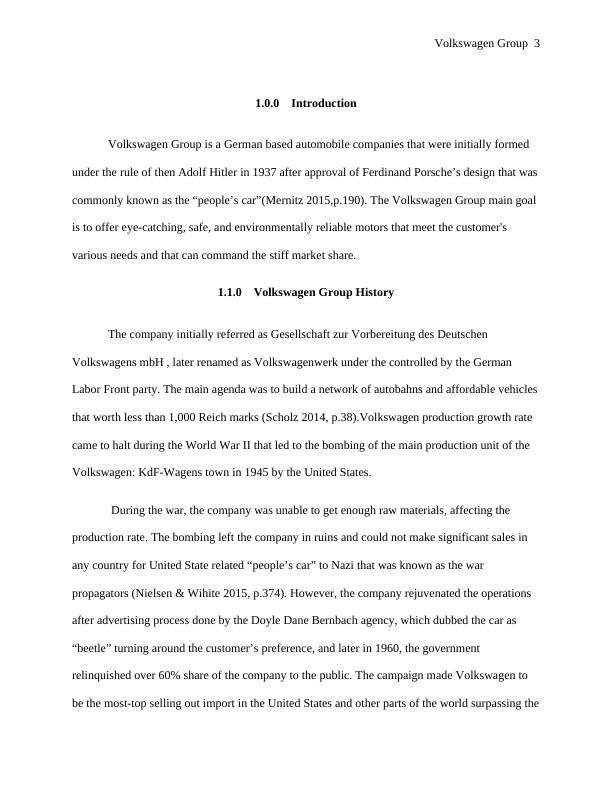
Volkswagen Group 4
1908 record set by Ford Motors of 15 million vehicles sales by 1972. Currently, Volkswagen
group has a collection of various automobile manufacturers such as Skoda, Porsche, Ducati,
Bugatti, Scania, Audi, Lamborghini, and MAN.
2.0.0 Marketing Segmentation and Strategy
Volkswagen came into existence to manufacture people’s car in Germany with primary
objective of providing affordable cars to the large group of the German since they were to cost
no more than 1,000 Reich marks. However, the company later changed the goals and embarked
on manufacturing military cars such as SUV-like Kubelwagen and Schwimmwagen that affected
the sales in the global market. Currently, the company has a diversified market strategy to make
VW the global most preferred supplier of the automobile through the “Together program” that
aims at dominating the path in a harmonious coexistence and equal exchange. Together program
aims at fulfilling the company’s dream of becoming the first automobile to sell 10 million cars in
a year with the base target being 2018 from the current average sales of 6 million a year (Bauer
2013, p.112). The company has introduced about nine brands that have unique portfolio since it
came into existence; these are Volkswagen, seat, Skoda, Volkswagen commercial vehicles,
Bugatti, Audi, Bentley, Lamborghini, and Scania.
1908 record set by Ford Motors of 15 million vehicles sales by 1972. Currently, Volkswagen
group has a collection of various automobile manufacturers such as Skoda, Porsche, Ducati,
Bugatti, Scania, Audi, Lamborghini, and MAN.
2.0.0 Marketing Segmentation and Strategy
Volkswagen came into existence to manufacture people’s car in Germany with primary
objective of providing affordable cars to the large group of the German since they were to cost
no more than 1,000 Reich marks. However, the company later changed the goals and embarked
on manufacturing military cars such as SUV-like Kubelwagen and Schwimmwagen that affected
the sales in the global market. Currently, the company has a diversified market strategy to make
VW the global most preferred supplier of the automobile through the “Together program” that
aims at dominating the path in a harmonious coexistence and equal exchange. Together program
aims at fulfilling the company’s dream of becoming the first automobile to sell 10 million cars in
a year with the base target being 2018 from the current average sales of 6 million a year (Bauer
2013, p.112). The company has introduced about nine brands that have unique portfolio since it
came into existence; these are Volkswagen, seat, Skoda, Volkswagen commercial vehicles,
Bugatti, Audi, Bentley, Lamborghini, and Scania.
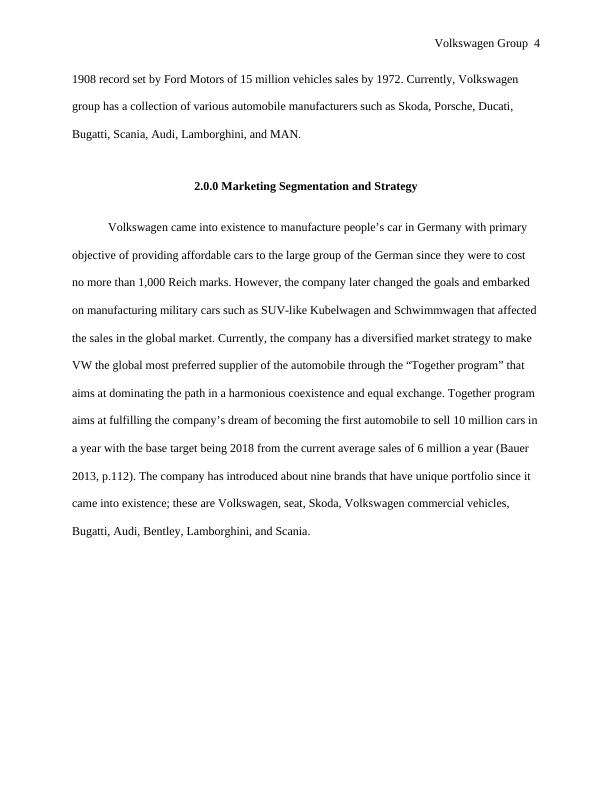
Volkswagen Group 5
2007 2008 2009 2010 2011
0
20,000
40,000
60,000
80,000
100,000
120,000
140,000
160,000
180,000
200,000
Sales and revenue evolution
sales and revenue evolution
Figure 1shows sales growth of the VW Group
The current company segmentation based on the psychological, personality and lifestyle
characteristic of the customers. The information collected from the market surveys enables the
company to produce various cars that meet each and every need of the large population of the
company (Wetland 2016, p.392). The company new creations target different market segments
that are in responses to the customer needs. For example, the new beetle segments to the young
people between the ages of 18 to 34 and the baby boomers who want to recapture the childhood
memories of the original Beetle.
The baby boomer tends to have a secure emotional connection with the original Beetle
making it easy for the company to market and make significant sales on the new Beetle car
(Altenburg, Schamp & Chaudhary 2016, p.467). The new beetle ranges to the average between
the U.S family incomes of $ 86,000 making it affordable among a large group of people. The
Audi brand is considered to be more luxurious and less costly, hence targets the middle-class
2007 2008 2009 2010 2011
0
20,000
40,000
60,000
80,000
100,000
120,000
140,000
160,000
180,000
200,000
Sales and revenue evolution
sales and revenue evolution
Figure 1shows sales growth of the VW Group
The current company segmentation based on the psychological, personality and lifestyle
characteristic of the customers. The information collected from the market surveys enables the
company to produce various cars that meet each and every need of the large population of the
company (Wetland 2016, p.392). The company new creations target different market segments
that are in responses to the customer needs. For example, the new beetle segments to the young
people between the ages of 18 to 34 and the baby boomers who want to recapture the childhood
memories of the original Beetle.
The baby boomer tends to have a secure emotional connection with the original Beetle
making it easy for the company to market and make significant sales on the new Beetle car
(Altenburg, Schamp & Chaudhary 2016, p.467). The new beetle ranges to the average between
the U.S family incomes of $ 86,000 making it affordable among a large group of people. The
Audi brand is considered to be more luxurious and less costly, hence targets the middle-class
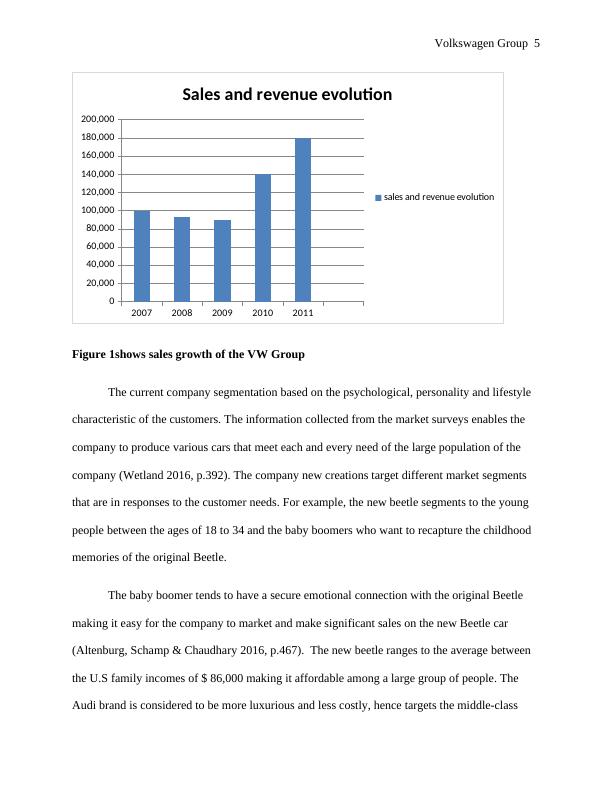
Volkswagen Group 6
customers, while Porsche and Lamborghini's brand targets the high-class individual who is either
the state official or the tycoons who want to drive on machines that range from $ 250,000
(Cundy & Hornak 2017, p.27).
The Volkswagen –Das Auto is the slogan used currently by the company to market the
new products. The bottom-line of the ‘Das-Auto’ combines three major aspects that are
innovativeness, provision of long-lasting value and responsibility tends to attract customers
across the world, as the brand promise better quality, reliability, and German engineering aspects
(Nelson 2015). The company’s aim of “customers first” allows the production of vehicles that
meet the needs of a large number of people in the country and across the world. The pricing of
the commodities based on the merchandise, the economy of the targeted country, the region and
the price of the competitor products making the company experienced massive sales as shown in
figure 1.
20%
18%
29%
3%
2%
3%
Global percntage sales of VW cars
Germany
France
Others
Brazil
USA
Spain
Figure 2 showing global market share of VWG
customers, while Porsche and Lamborghini's brand targets the high-class individual who is either
the state official or the tycoons who want to drive on machines that range from $ 250,000
(Cundy & Hornak 2017, p.27).
The Volkswagen –Das Auto is the slogan used currently by the company to market the
new products. The bottom-line of the ‘Das-Auto’ combines three major aspects that are
innovativeness, provision of long-lasting value and responsibility tends to attract customers
across the world, as the brand promise better quality, reliability, and German engineering aspects
(Nelson 2015). The company’s aim of “customers first” allows the production of vehicles that
meet the needs of a large number of people in the country and across the world. The pricing of
the commodities based on the merchandise, the economy of the targeted country, the region and
the price of the competitor products making the company experienced massive sales as shown in
figure 1.
20%
18%
29%
3%
2%
3%
Global percntage sales of VW cars
Germany
France
Others
Brazil
USA
Spain
Figure 2 showing global market share of VWG
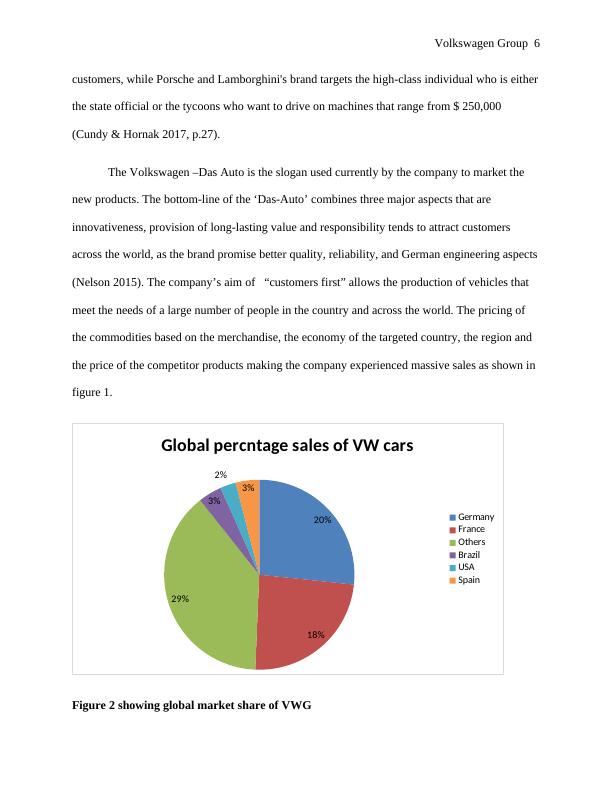
End of preview
Want to access all the pages? Upload your documents or become a member.
Related Documents
Porsche Incorporated into the Standard Modellg...
|10
|2610
|464
(PDF) Strategic Marketing Management : Assignmentlg...
|48
|15924
|149
